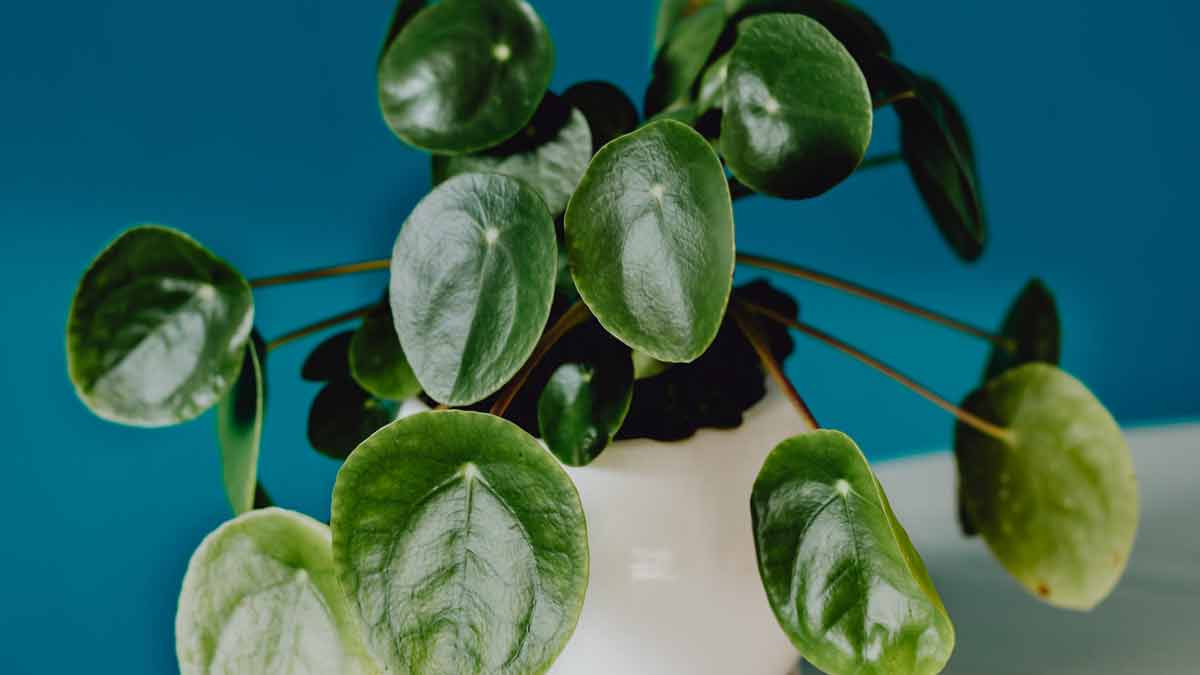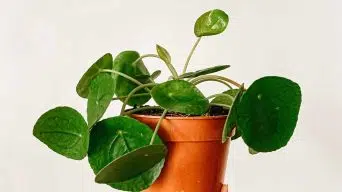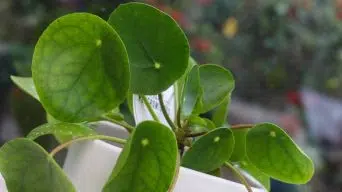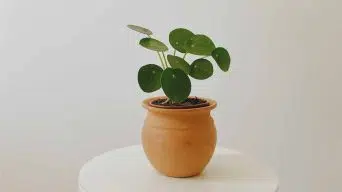Key Takeaways
- Pilea plants can droop due to overwatering, lack of proper drainage, pests, diseases, insufficient light, and temperature extremes.
- To prevent drooping in your Pilea plant, check for pests and diseases regularly while ensuring good drainage and adjusting the watering schedule based on soil moisture levels.
- Proper lighting is crucial for healthy plant growth and monitoring temperature and humidity levels. Repotting may also be necessary if other causes have been ruled out.
Pilea plants, also known as Chinese Money Plants or Pancake Plants, are popular indoor houseplants due to their intriguing appearance and low-maintenance requirements.
However, one common issue many plant owners face is drooping leaves – a sign of an unhappy pilea.
Numerous factors can cause your once vibrant pancake plant to look sad and unhealthy.
This blog post will explore the typical culprits behind droopy pileas and offer practical solutions to bring your beloved plant back to life.
Common Causes For Pilea Drooping
Pilea leaves may droop for various reasons, such as improper watering, lack of drainage, pest infestation, diseases, insufficient light, temperature fluctuations, and transplant shock.
Overwatering
Excessive watering often causes Pilea plants to droop, primarily due to the risk of root rot and a weakened plant structure.
When too much water is provided, the roots cannot take up oxygen and nutrients from the soil, ultimately causing the leaves to sag.
To avoid excessive watering for your Pilea, it’s crucial to learn how often and how much water your plant needs based on light exposure or pot size.
Typically, you should wait until at least half of the soil in the pot has dried before watering again.
Remember that Pileas need less frequent watering during winter when their growth slows down.
Underwatering
Underwatering is a common cause of drooping in Pilea plants. As a plant owner, it’s essential to understand the watering needs of your Pilea to ensure it remains healthy and vibrant.
When a Pilea is not receiving enough water, its leaves can begin to curl, lose their firmness, and eventually droop.
To determine if underwatering is the issue with your drooping Pilea, inspect the soil by touching it or using a moisture meter.
Dry soil often indicates that underwatering may be causing your pileas leaves to droop.
A good rule-of-thumb for maintaining optimal moisture levels for this indoor plant is to allow the top inch or two of soil to dry out between watering sessions while ensuring you provide an ample amount each time you water.
Lack Of Proper Drainage
One common cause of Pilea drooping is the lack of proper drainage.
This issue occurs when water cannot easily escape from the pot, causing the soil to become overly saturated and creating an environment ripe for root rot.
To ensure good drainage, use a container with drainage holes at the bottom, or consider placing a layer of pebbles underneath the potting soil inside your plastic or terracotta pots.
Additionally, opting for well-draining soils, such as a mix containing perlite, can assist in avoiding overwatering issues that result in droopy leaves on your beloved indoor plants.
Pest Infestation
Pest infestation is a common cause of Pilea drooping and can be caused by spider mites, mealybugs, or scale insects.
These pesky visitors feed on the plant’s sap and can damage its leaves, causing them to droop.
To check for pests, inspect your Pilea regularly and look for tiny spots or webbing on the leaves.
To treat pest infestations in your Pilea, use natural remedies like neem oil or insecticidal soap instead of harsh chemicals that may harm your plant.
Neem oil repels pests, while insecticidal soaps suffocate them effectively without harming the environment.
Taking preventive measures like monitoring your plants regularly and removing pests at first sight using natural remedies will help keep those troublesome bugs at bay, allowing you to have healthy looking Pileas all year round!
Diseases
Diseases can also be a reason why your Pilea is drooping.
Common diseases that affect these plants include fungal infections such as powdery mildew, which may cause leaves to turn yellow or brown and drop off prematurely.
Another common fungus affecting indoor plants is root rot, caused by overwatering or poor drainage.
Prevention of diseases includes ensuring proper watering techniques and soil quality.
If you suspect your Pilea has a fungal infection, removing all affected areas immediately is best to prevent spreading.
Regular inspection of your Pilea plant for pests and signs of disease is vital in keeping them healthy and thriving.
Insufficient Light
One of the most common causes of Pilea drooping is insufficient light.
These plants thrive in bright, indirect sunlight and should be placed near a window or under a grow light that provides adequate lighting.
If your plant does not receive enough light, its leaves may curl and droop.
For example, if you notice that your pilea’s leaves are pointing downwards instead of facing upwards, it could indicate that it’s not getting enough light.
To solve this problem, try moving the plant to a brighter location or supplementing it with artificial lighting.
Temperature
Pileas are native to Yunnan Province and thrive in warm temperatures between 60°F to 75°F.
Extreme temperatures can cause Pilea to droop, with cold temperatures being a common culprit.
Room temperature fluctuations can also lead to Pilea drooping and curling, particularly if the plant is exposed to hot or cold drafts from windows or air conditioners.
To avoid this, try adjusting the temperature or moving your plant away from areas that experience unpredictable temperature changes.
Similarly, when repotting into a new container for growth, choose an appropriate pot size that won’t overexpose roots and provide insulation against sudden changes in environmental conditions.
Transplant Shock
Transplant shock is a common cause of Pilea drooping.
Moving your plant to a new pot can experience stress due to changes in environment and soil conditions.
This stress can cause leaves to wilt or even fall off.
To prevent transplant shock, ensure the roots are not damaged during repotting and avoid disturbing them too much.
If your Pilea is already experiencing transplant shock, there are some steps that you can take to help it recover.
First, ensure that the soil is moist but not waterlogged – overwatering can worsen the condition of your plant.
You should also reduce environmental stressors by providing adequate lighting and adjusting temperature levels if necessary.
Solutions For Pilea Drooping
If you notice your Pilea plant drooping, there are several things you can do to help.
Adjust the watering schedule, ensure the plant has proper drainage, check for any pests or diseases, move it to a location with enough light, monitor the temperature and humidity levels, or consider repotting the plant if needed.
Adjust The Watering Schedule
Adjusting the watering schedule is crucial to prevent drooping in your Pilea plant.
Here are some tips to help you:
- Check your plant’s soil moisture level regularly and water it when the top inch of the soil feels dry.
- Avoid overwatering your Pilea by ensuring that excess water can drain out of the pot via drainage holes.
- Water your plant less frequently during the winter months when it’s dormant.
- Remember that every environmental factor, such as humidity and light, affects how often you should water your plant.
Ensure Proper Drainage
It is important to ensure proper drainage for your plant to prevent Pilea drooping.
Here are some tips on how to do this:
- Check the soil: Make sure the soil where your Pilea is planted has good drainage capacity. The soil should be well-draining and not become too compacted.
- Use the right pot: Choose a pot with drainage holes at the bottom so that excess water can escape easily. A terracotta pot or one made of porous material is ideal.
- Add a layer of gravel: Place a layer of gravel or pebbles at the bottom of the pot before adding soil. This will help with drainage and prevent roots from sitting in water.
- Don’t overwater: Water your Pilea only when the top inch of soil feels dry. Overwatering can lead to root rot and other problems that can cause drooping.
- Be mindful of humidity levels: Pileas prefer moderate to high humidity, but excess moisture can lead to drooping leaves. Monitor humidity levels and adjust as necessary.
Check For Pests And Diseases
It is essential to check for pests and diseases as they can cause Pilea to droop.
Here are some steps to help you identify and address any issues:
- Check the leaves for discoloration, spotting, or abnormalities.
- Look closely at the plant for signs of insects such as spider mites or mealybugs.
- Treat any pests or diseases immediately with appropriate methods such as neem oil or insecticidal soap.
- Avoid over-fertilizing your plant, as it can make it more susceptible to disease.
Regularly checking your Pilea for pests and diseases can prevent potential damage and keep your plant healthy.
Move To A Better Location With Adequate Light
If you’ve ruled out watering issues and pests, but your Pilea still appears droopy, it could be due to inadequate light.
Here are some tips for finding a better location with adequate light:
- Consider placing your Pilea near a south-facing window. North-facing windows may not provide enough brightness.
- If you don’t have a suitable window, artificial light can help. LED grow lights are an excellent option and can provide the necessary spectrum of light that your plant requires.
- Ensure that the Pilea is not in direct sunlight. This can cause sunburn or leaf scorching.
By providing your Chinese Money Plant with adequate light, you’re setting it up for success and helping to prevent future drooping.
Monitor Temperature And Humidity Levels
When caring for your Pilea plant, monitoring the temperature and humidity levels closely is important.
Here are some tips to help you monitor them effectively:
- Use a thermometer to check the room temperature where your plant is located. Pileas prefer temperatures between 60-75°F (15-24°C), so make sure it’s not too hot or cold.
- Use a hygrometer to measure the humidity level in the air around your Pilea. Aim for 50-60% humidity, closer to their natural environment in Yunnan Province, China.
- If the air in your home is too dry, you can increase humidity levels by placing a tray of water near your plant, misting its leaves with water regularly, or investing in a humidifier.
- Avoid placing Pileas near heat sources or cold drafts, as these fluctuations can cause drooping leaves and stems.
- Be mindful of changes in outdoor temperature during different seasons – drastic fluctuations can affect indoor temperatures and humidity levels.
Repot The Plant
If your Pilea is drooping even though you’ve taken care of the common causes, it might be time to repot the plant.
Here are the steps to follow:
- Choose a new pot that is slightly larger than the current one. The new pot should have drainage holes made of terracotta or another breathable material.
- Prepare fresh soil. Mix peat moss, perlite, and potting soil in equal parts to create a well-draining mixture.
- Carefully remove the Pilea from its current pot, being mindful not to damage the roots.
- Gently loosen the root ball and remove any dead or damaged roots.
- Place a layer of fresh soil at the bottom of the new pot and position the Pilea in the center.
- Fill around the plant with fresh soil until it’s at the same level.
- Water thoroughly, but avoid saturating the soil.
- Place your freshly repotted Pilea in bright, indirect light and monitor its progress over the coming days and weeks.
Remember that repotting can be stressful for plants, so don’t be alarmed if your Pilea looks a little droopy right after being transplanted.
With some patience and care, your plant should recover soon enough!
Pilea Maintenance Tips To Prevent Drooping
To avoid drooping, it’s important to use soil that drains well and to have proper drainage in the pot.
This can be achieved by adding a drainage hole or using a terracotta pot.
Additionally, rotate the plant regularly to ensure even sunlight exposure and monitor humidity levels.
Use Well-draining Soil And Proper Pot Size
Using the right soil and pot size to prevent Pilea drooping is essential.
Here are some tips on how to get it right:
- Choose a well-draining soil mix that will allow water to pass through easily and not become compacted. Avoid using heavy soils such as garden soil or clay.
- Use a pot appropriate for your plant, allowing enough space for roots to grow but not too much so that the soil becomes waterlogged.
- Terracotta pots are better than plastic pots as they allow moisture and air to pass through the pot walls, preventing root rot.
- Repotting should be done every year or two, depending on how quickly your Pilea grows.
Remember, aerated and well-draining soil is important for preventing problems associated with overwatering, such as curling leaves.
Using a proper pot size is also vital in preventing Pilea drooping.
By following these tips, you can ensure that your plant stays healthy and vibrant!
Ensure Proper Drainage
It is crucial to ensure proper drainage to prevent drooping in your Pilea plant.
Excess water in the potting soil can lead to root rot and droopy leaves.
Here are some ways to ensure proper drainage:
- Choose a pot with drainage holes at the bottom.
- Use well-draining soil mix and avoid using heavy garden soil.
- Add a layer of gravel or pebbles at the bottom of the pot for better drainage.
- Do not let excess water collect in saucers; it can promote fungal growth and damage the roots.
- If you suspect drainage issues, gently remove the plant from its pot and check for compacted or waterlogged roots. If necessary, repot the plant with fresh soil.
Rotate The Plant For Even Sunlight Exposure
To ensure that your Pilea plant gets even sunlight exposure, it’s important to rotate the pot periodically.
Here’s how you can do it:
- Move the plant to a flat surface where you can easily access every side of the pot.
- Gently lift the pot and turn it 180 degrees so that the side facing away from the light is exposed.
- Tilt the pot slightly so that all sides of the plant receive an equal amount of light.
- Repeat this process every few days or once a week, depending on your schedule.
Rotating your Pilea will prevent one side of the plant from getting too much or too little sunlight, which can cause drooping leaves and other issues.
Additionally, rotating your plant regularly can encourage more balanced growth and help keep your plant looking healthy and beautiful!
Monitor Humidity Levels
To prevent Pilea drooping, it is essential to monitor humidity levels regularly.
Here are some tips for maintaining the proper humidity levels for your plant:
- Place a humidifier near your Pilea plant to boost humidity levels.
- Mist the leaves of your plant once or twice per week using a spray bottle filled with water.
- Place a tray of water nearby or pebbles in a saucer under your pot to increase humidity around your plant.
- Use a hygrometer to measure the humidity level around your plant and ensure it stays between 40-60%.
Maintaining proper humidity levels will prevent Pilea leaves from drooping and keep them looking lush and healthy.
Remember that dry air can cause significant damage to Pilea plants, so keeping an eye on the moisture content in the air is crucial for successful indoor gardening.
Regular Observation And Care
Regular observation and care are essential for Pilea maintenance to prevent drooping.
Here are some tips on how to take care of your plant:
- Check the soil moisture level weekly by inserting your finger about an inch below the surface. If it feels dry, water your plant.
- Inspect the leaves regularly for signs of pests or diseases like brown spots, yellowing leaves, or fungal growth.
- Rotate your plant weekly to ensure all sides get adequate sunlight exposure and grow evenly.
- Maintain consistent temperature and humidity levels by keeping your Pilea away from drafty areas and regularly checking the air moisture levels.
- Prune yellowing or older leaves occasionally to promote new growth and maintain a healthy look.
Following these simple steps, you can keep your Pilea healthy and prevent any drooping issues caused by neglect or lack of proper care.
Regular attention will also help you catch any problems before they become severe and potentially harm your plant’s health.
Final Thoughts
In conclusion, drooping Pilea leaves can be caused by various factors such as over or under-watering, insufficient light, pests, or diseases.
To prevent your beloved plant from drooping, monitoring its watering schedule and ensuring proper drainage is essential.
Additionally, relocating the plant to a better location with adequate lighting and maintaining optimal temperature and humidity levels can improve the overall health of your Pilea.







